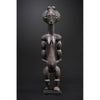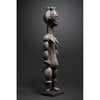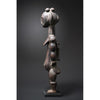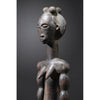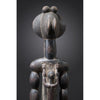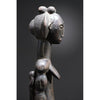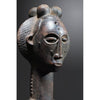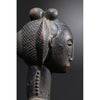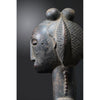See more: artifacts
Attie Maternity Rare and Impressive Figure, Côte d'Ivoire
$ 6,800.00 $ 3,400.00
- Attie Maternity Figure, Côte d'Ivoire
- A rare and impressive Attie Maternity Figure, based on a plinth, because her feet and left calf were damaged by insect wear. The Figure has strongly segmented arms and legs, a full abdomen with a long navel. The hands are supported against the abdomen, the small but long breasts are pointed forward, the neck is overlong, a small mouth under a straight long nose, the closed eyes are rimmed, a finely elaborated hairstyle with four "balls" on the head and more segments on the sides and back of the head. On the Mother's back hangs a small child with a very elongated torso.
- To be a Mother marks Female Social Completion in Africa. Without it, one is not quite an adult, or certainly not an adult who receives full respect. Sadly, without children, one cannot have a traditional funeral nor become an Ancestor. While these issues relate to men as well as women, infertile men can acquire children through cooperative wives who ensure they become pregnant; women do not have that option. In practical terms, women who are not mothers may be divorced or have to accept a co-wife. They have no support in their old age, for that is the duty of children, and–if their husband dies–they even may not have a place to live. Even those who are wealthy and self-sufficient suffer if childless. Even those who are unconcerned about financial support or Ancestorhood have to endure the pity or mockery of family members, friends, and acquaintances. Babies born after a longed-for conception often bear names that reflect their mothers’ anxiety. These Edo names from Nigeria’s Benin Kingdom are among many examples that reflect joy, triumph, and satisfaction in a successful delivery after the pain of barrenness. They pointedly refer to previous distress and are meant as retorts to those who might have tried to block their pregnancy or had made fun of them: Oghiomwanghaghomwan (“When one’s enemy looks at one”), Omoigiate (“Child protects one from shame”), or Aganmwonyi (“A childless person has no glory”).
- “The Eastern Coast of the Côte d'Ivoire comprises an area of Lagoons, where the population is divided into twelve different language groups. The Cultural and Stylistic Unity of these people justifies grouping the, together for the purposes of this chapter. Before colonization, each village was autonomous and, when threatened, they united to form a ‘confederation’. Unusually, these people are not governed by chiefs, although a man’s social position is determined by his age.” Lit.: Baquart, Jean-Baptiste. The Tribal Arts of Africa. New York: Thames and Hudson Inc. 1998.
- Measurements: 78cm
- Condition: Fair
- Sold with stand


